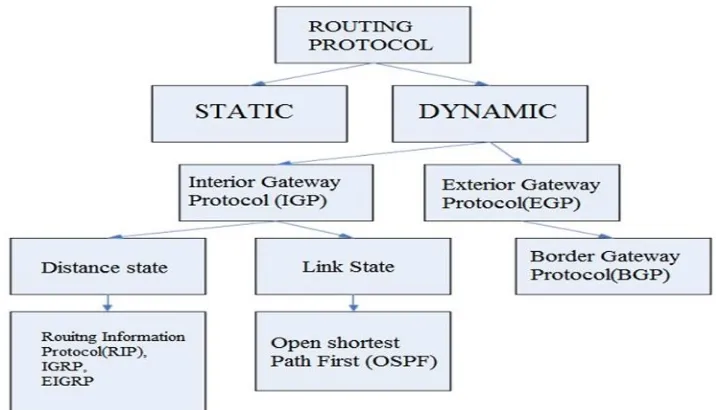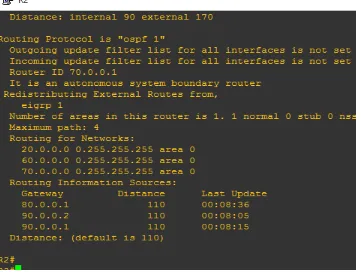Route Redistribution between EIGRP and OSPF
Routing Protocol Using GNS3 Sofware
Rishabh Srivastava1, Archana Singh2(Advisor)
1,2 Department Of CSE, Sam Higginbottom University of Agriculture, Technology and Sciences, Allahabad
Abstract: Routing plays very significant role to advertise the route of one network to another network as well to find the best path between sources to destination. In computing environment so many routing protocol like EIGRP and OSPF are used for sending IP packet from source to destination. But different routing protocol used different routing algorithm to find best path between sources to destination node. Whereas EIGRP is a Cisco Proprietary protocol that runs only Cisco router and OSPF is non Cisco Proprietary protocol that runs. So packet of EIGRP network cannot reach to OSPF network. So this research paper mainly focuses on to solve this problem by using Route Redistribution technique. Route redistribution (RR) has become an integral part of IP network design. Using this technique we can optimize the network by advertising the EIGRP route to OSPF network and vice versa.
Keywords: CISCO, RIP, EIGRP, OSPF, RR, AS.
I. INTRODUCTION
Routing is a process of exchanging IP packet from one network to another network. It also provides to find the best path for IP packet between source to destination with the help of Router. Router works at network layer of the OSI model and used to route IP packets to destination networks. This is possible as router used routing technique like static, default and dynamic routing. Static and default routing is configure by administrator manually. In dynamic routing, router used various routing protocol such as RIP, EIGRP and OSPF etc. Basically router performed routing to create a routing table and learn the neighbour route information. It is preferable to employ a single routing protocol in an internetwork environment, for simplicity and ease of management. Unfortunately, this is not always possible, making multi-protocol environments common. Route Redistribution allows routes from one routing protocol to be advertised into another routing protocol. The routing protocol receiving these redistributed routes usually marks the routes as external. External routes are usually less preferred than locally-originated routes.
A. Types of routing
Routing can be classified into two main categories accordingly to create a routing table.
1) Static route: In computer networking, the word static means manually. So in process administrator configure each router interface manually. So routing table is created, update and maintained by administrator manually, in this process router will not share our routing information with each other thus it reduced CPU/RAM overhead so as the result bandwidth is saved.
Fig. 1 Routing Overview of OSPF & EIGRP
B. Routing overview of OSPF and EIGRP
In IP networks, the main work of a routing protocol is to carry data packets and forward it from one node to another. In a network, routing can be defined as transmitting data from a source to a destination by hopping one-hop or multi hop. Routing protocols should provide minimum two facilities: firstly selecting routes for different pairs of source/destination nodes and, successfully transmitting data to a given destination. Routing protocols are used to describe how routers communicate to each other, build routing tables, make routing decisions and share information among neighbours. Routers are used to connect multiple networks and to provide packet forwarding for different types of networks. The main aim of routing protocols is to find the optimum path from a source to a destination. A routing algorithm uses different metrics based on a single or on several properties of the path in order to determine the best way to reach a given network.
1) OSPF (Open Shortest Path First): Open Shortest Path First (OSPF) is a very widely used link-state interior gateway protocols (IGP). This protocol routes Internet Protocol (IP) packets by gathering link-state information from neighbouring routers and constructing a map of the network. OSPF routers send many message types including hello messages, link state requests and updates and database descriptions. Djisktra’s algorithm is then used to find the shortest path to the destination. Shortest Path First (SPF) calculations are computed either periodically or upon a received Link State Advertisement (LSA), depending on the protocol implementation. Topology changes are detected very quickly using this protocol. Another advantage of OSPF is that its many configurable parameters make it a very flexible and robust protocol. Contrary to RIP, however, OSPF has the disadvantage of being too complicated.
2) IGRP (Enhanced Interior Gateway Routing Protocol) : EIGRP is a Cisco-developed advanced distance-vector routing protocol. Routers using this protocol automatically distribute route information to all neighbours. The Diffusing Update Algorithm (DUA) is used for routing optimization, fast convergence, as well as to avoid routing loops. Full routing information is only exchanged once upon neighbour establishment, after which only partial updates are sent. When a router is unable to find a path through the network, it sends out a query to its neighbours, which propagates until a suitable route is found. This need-based update is an advantage over other protocols as it reduces traffic between routers and therefore saves bandwidth. The metric that is used to find an optimal path is calculated with variables bandwidth, load, delay and reliability. By incorporating many such variables, the protocol ensures that the best path is found. Also, compared to other distance-vector algorithms, EIGRP has a larger maximum hop limitation, which makes it compatible with large networks. The disadvantage of EIGRP is that it is a Cisco proprietary protocol, meaning it is only compatible with Cisco technology.
II. PROBLEM DESCRIPTION
time than OSPF and IS-IS, it can be used in different network layer protocols and it is relatively easy to setup on the network. However, EIGRP is a CISCO proprietary protocol, which means that it can only be used on CISCO products. Moreover, their packets can’t reach to one another as they both are of different proprietary protocol and running on their own products. And due to this we can’t able to form the multi-protocol environments. So, in this paper we will solve this problem by using Route Redistribution technique by using the GNS3 simulator software.
III. SIMULATION TOOLS USED
[image:4.612.162.422.219.449.2]In our dissertation work we are using the GNS3 (Graphical Network Simulator) software for simulating selected routing protocols and thereby performing the route redistribution technique for learning of the networks by different protocols and making packet exchange between different networks.
Fig. 2 Flow chart of GNS 3 software
Graphical Network Simulator-3 (shortened to GNS3) is a network software emulator first released in 2008. It allows the combination of virtual and real devices, used to simulate complex networks. It uses Dynamips emulation software to simulate Cisco IOS.
IV. ROUTE OPTIMIZATION USING ROUTE REDISTRIBUTION
The use of a routing protocol to advertise routes that are learned by some other means, such as by another routing protocol, static routes, or directly connected routes, is called redistribution. While running a single routing protocol throughout your entire IP internetwork is desirable, multi-protocol routing is common for a number of reasons, such as company mergers, multiple departments managed by multiple network administrators, and multi-vendor environments. Running different routing protocols is often part of a network design. In any case, having a multiple protocol environment makes redistribution a necessity.
Differences in routing protocol characteristics, such as metrics, administrative distance, classful and classless capabilities can effect redistribution. Consideration must be given to these differences for redistribution to succeed.
A. Metric
B. Simulation setup
Fig. 3 Route Redistribution between EIGRP and OSPF
It shows the simulation of dynamic routing using GNS 3 software. We have developed a simulation networking model consisting of cisco routers and switches and make a physical connection by connecting cable to serial and fast Ethernet by using simulation tool GNS 3 Software.
1) Configuring CISCO Router: After implementation of physical model we are required to configure network with static routing means we are configuring all router interface manually. Router will be configured in two ways :
2) GUI (Graphical User Interface): With GUI we simply configure router by clicking the router then click configuration and then selected which type of configuration you want to configure.
3) CLI (Command Line Interface) Mode: In this mode, we can configure dynamic routing with the various commands.
[image:5.612.57.534.426.684.2]C. Simulation
Fig. 4 Route Redistribution at R2 router
Fig. 5 OSPF Redistributing routes through EIGRP at boundary router
[image:6.612.113.564.415.670.2]Figure 5 is showing about that the boundary Router 2 with ID 70.0.0.1 is redistributing external routes from EIGRP 1 for the routing protocol OSPF 1.
Figure 6 . router 1 is sending packets to last router 5
V. CONCLUSION
The objective of this paper is to distribute different routing protocols to different area of the networks with different routing protocols working on it. Dynamic routing used different routing protocol which are vendor proprietary (like RIP, EIGRP) or Non-vendor proprietary (OSPF), if we provide routing between Non-vendor proprietary (RIP,EIGRP) and Non-Non-vendor proprietary (OSPF), then we must have to ensure that route redistribution works between them. So Route redistribution (RR) has become an integral part of IP network design. Route redistribution provide important role to redistribute one route to another network. Basically it translates one routing protocol into another routing protocol without losing its information. But the main limitation is that when any route is lost then looping problem is occurs. Another technique is used to optimize the route like passive interface and route filter and policy routing.
VI.ACKNOWLEDGEMENT
I would like to take this opportunity to express my deep sense of gratitude to all who helped me directly or indirectly during this project work. I am highly obliged to my advisor Er. Archana Singh , and all the faculty members and staffs of Computer Science and IT Department for their support and encouragement. There were others who were very inspiring and would always encourage me through their actions and deeds.
REFERENCES
[1] FATIMA A.HAMZA,AMR M.MOHAMED,“PERFORMANCE COMPARISON OF TWO DYNAMIC ROUTING PROTOCOLS:RIP AND OSPF”,JOURNAL OF EMERGING TRENDS IN COMPUTING AND INFORMATION SCIENCES, VOLUME 2:OCTOBER 2011.
[2] Z.ZWEI,F.WANG,“ACHIEVING RESILIENT ROUTING THROUGH REDISTRIBUTING ROUTING PROTOCOLS”,COMMUNICATIONS (ICC),IEEEINTERNATIONAL CONFERENCE,1-5, 2011.
[3] P.R.GUNDALWAR1,DR.V.N.CHAVAN,“ROUTING BEHAVIOR OF IPROUTERS RUNNING RIP IN DIFFERENT SCENARIOS,INTERNATIONAL JOURNAL COMPUTER TECHNOLOGY &APPLICATIONS,VOLUME 4(2),302-311:MAR-APR 2013.
[4] JEEVAN PRASAD ADHIKARI,“PERFORMANCE ANALYSIS OF PROTOCOLS RIP&EIGRP USING GNS3SOFTWARE”,INTERNATIONAL JOURNAL OF INNOVATIVE TECHNOLOGYEXPLORING ENGINEERING (IJITEE),VOLUME-2,APRIL 2013
[5] INTERNATIONAL JOURNAL OF COMPUTER NETWORKING,WIRELESS AND MOBILE COMMUNICATIONS (IJCNWMC)VOL.5,ISSUE 1,FEB 2015,27-34©TJPRC PVT.LTD.
[6] INTERNATIONAL JOURNAL OF ENGINEERING RESEARCH AND GENERAL SCIENCE VOLUME 3,ISSUE 2,PART 2, MARCH-APRIL,2015.



